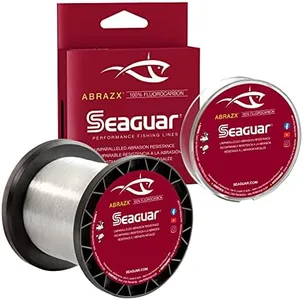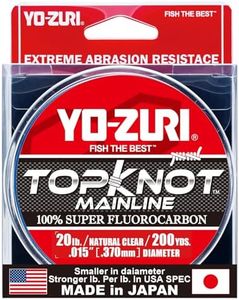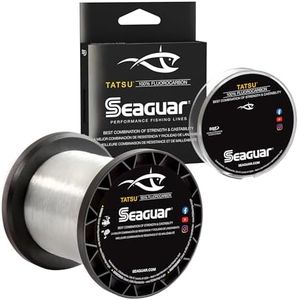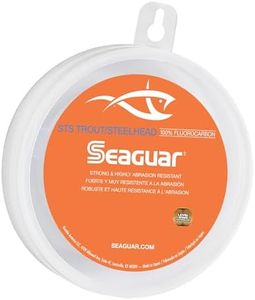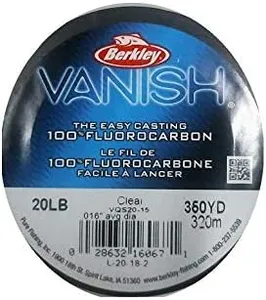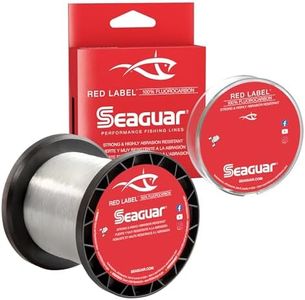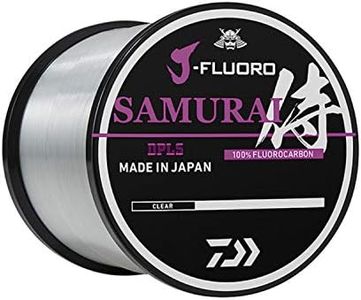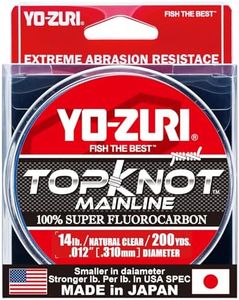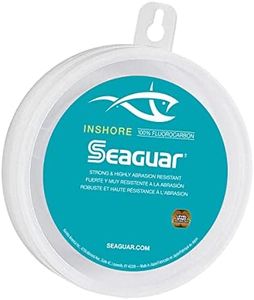We Use CookiesWe use cookies to enhance the security, performance,
functionality and for analytical and promotional activities. By continuing to browse this site you
are agreeing to our privacy policy
10 Best Fluorocarbon Lines
From leading brands and best sellers available on the web.By clicking on a link to a third party's website, log data is shared with that third party.
Buying Guide for the Best Fluorocarbon Lines
Choosing the right fluorocarbon fishing line can greatly impact your fishing experience, improving your chances of a successful catch and making handling your gear easier. To find the line that best fits your needs, it’s important to understand which features matter the most for your style of fishing, types of fish you’re targeting, and the waters where you’ll be casting. By evaluating the main specifications, you can make a confident choice that balances strength, sensitivity, and manageability.Pound Test (Line Strength)The pound test rating tells you how much weight a line can hold before breaking. This is crucial because it needs to match the size of fish you're after; too light and you risk losing your catch, too heavy and the line may be unnecessary stiff, less sensitive, or more visible. Light lines (2-8 lb) are good for small fish or light fishing scenarios like freshwater streams. Medium lines (8-15 lb) handle general fishing and medium-sized fish, while heavy lines (15 lb and above) are used for larger fish or tough conditions. Pick a pound test that matches the fish you target and the cover or structure in the water.
DiameterThe diameter of fluorocarbon line affects not only how visible it is to fish, but also the way your lure or bait behaves in water. Thinner lines are less visible and allow for more natural movement, while thicker lines are tougher against abrasion but may spook wary fish and reduce casting distance. For clear water and stealthy presentations, choose a thinner diameter; for heavy cover or abrasive environments, a thicker diameter offers more protection.
Abrasion ResistanceAbrasion resistance represents how well the line holds up against rough surfaces like rocks, wood, or shells in the water. Lines with high abrasion resistance are important if you’re fishing around heavy cover or structures where your line may rub against obstacles. If you fish in open, clear water where the line stays away from damaging surfaces, you might not need the highest abrasion resistance.
Visibility/ClarityOne of fluorocarbon’s main advantages is its low visibility underwater, but clarity levels can vary between lines. If you fish in clear or pressured waters where fish are line-shy, look for lines marketed as extra-invisible or ultra-clear. If visibility is less of a concern—such as in murky water—you can use standard clarity.
Stretch/SensitivityFluorocarbon stretches less than some other lines, making it more sensitive for detecting strikes and subtle movement. Less stretch offers better feedback but can be less forgiving during a hard fight. If you want to feel every bite immediately, pick a line with minimal stretch. For applications where shock absorption is helpful, a bit more stretch can prevent break-offs.
MemoryLine memory means how much the line retains the shape of the spool after being uncoiled. High memory can cause tangles, loops, or casting problems. If you often cast long distances or use spinning reels, choose a line with low memory for smoother performance. If you primarily use baitcasting reels or fish short distances, moderate memory may be manageable.
Sink RateFluorocarbon naturally sinks faster than many other types of fishing line. The exact sink rate can be important depending on your fishing technique and the depth you want to target. For bottom baits or deep-water presentations, a faster sink rate helps get your lure down quickly. For topwater fishing, a slower sink rate avoids dragging your bait under.
